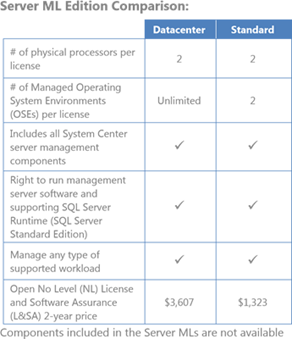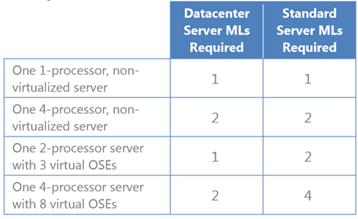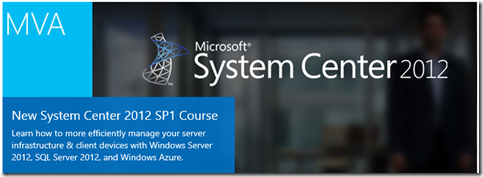System Center 2012 SP1– Overview
System Center 2012 SP1 has been on most of our radars since Windows Server 2012 was released.
as you know, when release in Q2 of 2012, System Center 2012 didn’t support the unreleased Windows Server 2012 operation system. The original System Center 2012 release was designed for Windows Server 2008 R2. The new System Center 2012 SP1 takes care of that by adding full support for all the new features in Windows Server 2012.
The Cloud OS does what a traditional operating system does – manage applications and hardware – but at the scope and scale of cloud computing. The foundations of the Cloud OS are Windows Server 2012 and Windows Azure, complemented by the full breadth of our technology solutions, such as SQL Server, System Center and Visual Studio. Together, these technologies provide one consistent platform for infrastructure, apps and data that can span your datacenter and the Microsoft public cloud.
In other words, it’s a Server OS combined with the required tools and back-end (Visual Studio, SQL,….) and a management platform (System Center 2012 SP1) that allows you to:
- Manage scale, elasticity, and availability
- Enable Modern Apps
- and, enable a people centric IT. (Today’s users need to be productive wherever they choose, on whatever device they choose)
With System Center 2012 SP1, you can manage all your cloud-based applications and your resources running in your datacenters, on a hosted service provider datacenter or on Windows Azure.
System Center 2012 SP1 includes all the following goodness.
- App Controller
- Operations Manager
- Orchestrator
- Service Manager
- Virtual Machine Manager
- Data Protection Manager
- Endpoint Protection
- Configuration Manager
App-Controller gives application owners the power to:
- Easily configure, deploy, and manage services through a highly intuitive service-centric interface that relies on a library of standardized templates to help ensure compliance with IT policies.
- Manage virtual machines, clouds, and application services across these environments on their own, using a customized view of applications based on their organizational role. This enables them to focus on managing services rather than servers.
- View on-premises, service provider, and Windows Azure services as well as virtual machines, and get granular control of the components at each layer, track jobs, and maintain a detailed history of changes.
Operations Manager delivers flexible and cost-effective enterprise-class monitoring and diagnostics.
- Reducing your TCO by leveraging commodity hardware configurations and heterogeneous environments.
- Helping to ensure the availability of business-critical applications and services through deep .NET application performance monitoring, diagnostics, and JEE application health monitoring.
- Providing a comprehensive view of datacenters, and private and public clouds health.
Orchestrator gives IT administrators the capabilities to perform many tasks and procedures to keep the health of their computing environment up-to-date and their business running.Tasks might include the following diverse activities, for example, new employees require that accounts and resources are configured, a business acquisition requires integrating a system from another vendor, and new hardware requires provisioning. Individual tasks and subtasks are automated, but typically, not the whole process. In addition, the administrators must maintain quality standards and system efficiency. System Center 2012 - Orchestrator can tie disparate tasks and procedures together by using the graphical user-interface Runbook Designer to create reliable, flexible, and efficient end-to-end solutions in the IT environment.
- Automate processes in your data center, regardless of hardware or platform.
- Automate your IT operations and standardize best practices to improve operational efficiency.
- Connect different systems from different vendors without having to know how to use scripting and programming languages.
Service Manager provides an integrated platform for automating and adapting your organization’s IT service management best practices, such as those found in Microsoft Operations Framework (MOF) and Information Technology Infrastructure Library (ITIL). It provides built-in processes for incident and problem resolution, change control, and asset lifecycle management.
Virtual Machine Manager is a management solution for the virtualized datacenter, enabling you to configure and manage your virtualization host, networking, and storage resources in order to create and deploy virtual machines and services to private clouds that you have created.
Data Protection Manager is a server-based application that enables disk-based and tape-based data protection and recovery for computers in and across Active Directory domains. DPM performs replication, synchronization, and recovery point creation to provide reliable protection and rapid recovery of data both by system administrators and by end-users. Data Protection Manager uses replication, the Volume Shadow Copy Service (VSS) infrastructure, and a policy-driven engine to provide businesses of all sizes with nearly continuous protection and rapid, reliable data recovery.
Endpoint Protection provides an antimalware and security solution for the Microsoft platform. When System Center 2012 Endpoint Protection is used with Microsoft System Center 2012 Configuration Manager, it provides a comprehensive enterprise management solution that lets you do the following:
- Centrally deploy and configure the Endpoint Protection client.
- Configure default and custom antimalware policies that apply to groups of computers.
- Create and deploy Windows Firewall settings to groups of computers.
- Use Configuration Manager software updates to automatically download the latest antimalware definition files to keep client computers up-to-date.
- Control who manages the antimalware policies and Windows Firewall settings by using the Endpoint Protection Manager security role.
- Use email notifications to alert you when computers report that malware is installed.
- View summary and detailed information from the Configuration Manager console and reports
Configuration Manager provides a comprehensive solution for change and configuration management for the Microsoft platform. System Center 2012 Configuration Manager lets you perform tasks such as the following:
- Deploy operating systems, software applications, and software updates.
- Monitor and remediate computers for compliance settings.
- Monitor hardware and software inventory.
- Remotely administer computers.
System Center 2012 licensing
You can find the official licensing requirements documentation here. (https://www.microsoft.com/en-us/server-cloud/system-center/default.aspx)
SC2012 licensing maximizes your private cloud value while simplifying purchasing. (which is always a good thing) All server management licenses (SMLs) include the same components and the ability to manage any workload.
System Center 2012 SMLs are available in two editions differentiated by virtualization rights only:
- Datacenter: Maximizes cloud capacity with unlimited virtualization for high density private clouds
- Standard: For lightly or non-virtualized private cloud workloads
(this table was taken from the Licencing document found here https://download.microsoft.com/download/1/1/1/11128EC7-2BE7-480C-9D46-4ECECA9E481A/System%20Center%202012%20Licensing%20Datasheet.pdf )
Server management licenses (MLs) are required for managed devices that run server Operating System Environments (OSEs). Licenses are processor-based, with each license covering up to two physical processors. The number of Server MLs required for each managed server is determined by the number of physical processor in the server for Datacenter Edition and either number of physical processors in the server or number of OSEs being managed for Standard Edition (whichever is greater). If you choose the Standard Server ML, you can add more licenses to a server to manage a greater number of virtual OSEs.
For example:
“Where can I get ramped up on all this goodness?” you ask…
Well Microsoft Virtual; Academy is your friend. and our friend Morgan Webb has prepared a great link that outlines a lot of the training tools at MVA. you can find the post here.
But I have included the some of the content below:
Configure & Deploy
Infrastructure
Configure & Deploy Infrastructure Components with System Center 2012 SP1 - Part 1 – Compute here
Configure & Deploy Infrastructure Components with System Center 2012 SP1 - Part 2 – Storage here
Configure & Deploy Infrastructure Components with System Center 2012 SP1 - Part 3 – Network here
Configure & Deploy Infrastructure Components with System Center 2012 SP1 - Part 4 – Network here
Configure & Deploy Infrastructure Components with System Center 2012 SP1 - Part 5 – Cluster here
Private Cloud
Configure & Deploy Private Cloud Infrastructure with System Center 2012 SP1 - Part 1 – Abstraction here
Configure & Deploy Private Cloud Infrastructure with System Center 2012 SP1 - Part 2 - Heterogeneity & Control here
Configure & Deploy Private Cloud Infrastructure with System Center 2012 SP1 - Part 3 – Expansion here
Applications
Configure & Deploy Applications with System Center 2012 SP1 - Part 1 here
Configure & Deploy Applications with System Center 2012 SP1 - Part 2 here
Service Delivery & Automation
Configure & Deploy Service Delivery & Automation with System Center 2012 SP1 - Part 1 – Standardization here
Configure & Deploy Service Delivery & Automation with System Center 2012 SP1 - Part 2 – Self-Service & Systems Automation here
Monitor & Operate
Infrastructure
Monitor & Operate Infrastructure Components with System Center 2012 SP1 - Part 1 - Proactive & Corrective here
Monitor & Operate Infrastructure Components with System Center 2012 SP1 - Part 2 - Standardize & Available here
Private Cloud
Monitor & Operate Private Cloud Infrastructure with System Center 2012 SP1 - Part 1 - Cloud Utilization here
Monitor & Operate Private Cloud Infrastructure with System Center 2012 SP1 - Part 2 - Control Access here
Monitor & Operate Private Cloud Infrastructure with System Center 2012 SP1 - Part 3 - Application Servicing here
Applications
Monitor & Operate Applications with System Center 2012 SP1 - Part 1 here
Monitor & Operate Applications with System Center 2012 SP1 - Part 2 here
Service Delivery & Automation
Monitor & Operate Service Delivery & Automation with System Center 2012 SP1 - Part 1 - Integration & Management here
Monitor & Operate Service Delivery & Automation with System Center 2012 SP1 - Part 2 – Reporting here
But wait… There’s more…
(with the Shamwow guy’s voice…)
There are also the following very interesting sessions:
- Learn how your IT organization can manage and secure PCs, tablets (Surface, iPad, etc.) and mobile devices (Windows Phone, Android, iPhone) in the cloud.
- Windows Intune for IT Professionals Jump Start on January 31, 2013, 9:00am-5:00pm PST
- This is the first of a three course series and is designed for IT Pros experienced in virtualization (i.e., VMware) but in need of learning how to leverage Hyper-V to perform essential tasks in the Windows Server 2012 platform.
- Introduction to Hyper-V Jump Start on January 24, 2013, 8:00am-5:00pm PST
- This is the second of a three course series and is tailored for VMware professionals looking to get up-to-speed on how Windows Server 2012 Hyper-V and System Center 2012 SP1 compares with VMware vSphere 5.1 and VMware’s Private Cloud, respectively.
- Virtualization for VMware Professionals Jump Start on January 30, 2013, 8:00am-5:00pm PST
So go ahead!!
Download Microsoft System Center Private Cloud Evaluation Software
Cheers!
Pierre Roman, MCITP , ITIL | IT Pro AdvisorTwitter | Facebook | LinkedIn




